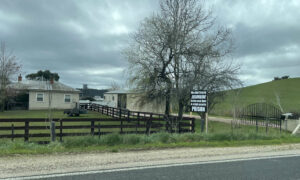The bright-coloured brochures present an enticing image: ‘Tasmania’s Pristine South’, a ‘pure’ region of crystal clear waters, towering forests, flourishing wildlife and jovial, contented country-folk. It would be a great place to take my mum for the weekend, I thought. She is ill…well let’s not beat around the bush, she has terminal lung cancer. She’s not well at all. This would probably be her last weekend away, her last holiday. So we checked the weather and rented accommodation near Dover. It was going to be a perfect autumn weekend: 22 Degrees, calm, the best kind of Tasmanian weather.
We arrived by lunchtime on Saturday. At first, it was great: we swam, we walked in the bush, we cooked and talked. My mum watched as her three kids ran around outside. She can’t get out of bed much anymore. But by the late afternoon, a frightening spectacle had been unleashed from the forested hills behind Dover. First one, then two, then three vast columns of acrid brown smoke rose from the hinterland, sending thick plumes high into the atmosphere. Then there was another, then so many that the smoke had fused into a hazy mass and we couldn’t count them any more. It didn’t look like the pictures in the brochures. By evening, an eerie red glow behind the town illuminated a huge scar in the sky.
Picture: Will Mooney
Picture: Will Mooney
Next morning I woke to the smell of smoke. Outside, stifling smog of brown fumes had obscured the whole landscape. To the South, the ‘majestic’ Adamson’s Peak was just a faint pointy outline above a pall of brown. To the East, Bruny Island was invisible, the still sea shaded into an endless mass of dirty grey. It stank. My throat was dry, I was congested. Then I thought about my mum. These days, she struggles to breathe at the best of times. Not surprisingly, she was incensed. She sat there forlornly, looking at the damaged day, at the big smear in the sky. My sister lives in Melbourne, its gets polluted there too sometimes, but never this bad. Never as bad as our autumn weekend in the ‘pristine south’.
We didn’t want to ruin our holiday, but we were faced with a challenge. What were we going to do? We couldn’t just ignore this. It seemed like a viciously careless attack on the whole community had been launched. It seemed unfair that my mum, let alone the rest of the state, had to suffer this hideous pollution. So we spent most of our Sunday scouring the phonebook, calling the relevant authorities and drafting letters to the editor.
I don’t think we were alone in this predicament. It is a challenge faced by so many Tasmanians at this time of year: how do you deal with this frightening, ugly assault on the sky, on our air, on our lives, our health, our lungs? What can you do? You’ve called the complaint lines; you’ve talked to politicians, written letters to the paper, called talkback. But year after year, the smoke – the choking haze – doesn’t subside; in fact it seems to get worse. It’s tempting to try and forget, to ignore it, pretend its not happening, to look at the ground, stay inside. Try not to breathe too deep. Sometimes it feels like the only thing you can do. It certainly seems like the approach that many of our community leaders have taken. Like the Asthma Foundation, that advises sufferers to stay inside, lock their doors; be ‘alert but not alarmed’. It’s a sophisticated take on burying your head in the sand.
Sometimes we all want to bury our heads in the sand. But the annual desecration of our forests and air is so utterly beyond justification, so blatantly and inexcusably wrong, that many Tasmanians find it simply impossible to ignore. As I drove back from Dover that weekend, I saw many people with cameras aloft, photographing the vile red stain across the sky. They weren’t taking these snaps to put in their photo albums or show to relatives, they were taking them to capture their emotion and anger, to document their outrage. And they had every reason to.
Modern research demonstrates, without any doubt, that the particulates and pollutants that make up this smoke are seriously damaging to human health. These tiny particles travel deep into our lungs and can aggravate lung-related diseases and contribute to numerous health problems. Tasmanian research has even indicated that this wood smoke may be worse for people’s health than exhaust smoke. Imagine a dense cloud of exhaust smoke across Tasmania. Would be tolerate that?
In America, reputable medical organizations have complained to congress about the impact of smoke from wood fired power stations, explaining that it can pose ‘severe impacts on the health of children, older adults, and people with lung diseases’. According to researchers from the Harvard Medical School, particulate pollution “is the most
important contaminant” in our air. “When particle levels go up,” they explain, “people die.”
Even our Department of Health and Human Services seems alert to the inherent health risks, explaining that the gases produced by these burns include “carbon monoxide, carbon dioxide, nitrogen oxides and volatile organic compounds.” The “typical effects” of exposure to these gases, the DHHS explains, include irritation of the eyes, sore throat, runny nose and coughing. Children, the elderly, smokers and people with pre-existing illnesses such as heart or lung conditions (including asthma) are more sensitive to the effects of breathing in these fine particles. The DHHS is, then, fully aware of the dire health implications of these burns, but year after year we are asked to nurse our irritated eyes, congested sinuses and hacking coughs with nowhere to turn.
It is not an exaggeration to state that, during these burns, all Tasmanians are being subjected to a dangerous and reckless health threat that is unleashed with the full knowledge and even backing of our authorities. To me, this represents a fundamental violation of our social contract and a breakdown of fundamental reason. Don’t we elect governments and institute laws to prevent this kind of thing, to reign in marauding, self-interested parties who impose their will regardless of the welfare of the wider community?
In 2009 the Forest Practices Authority was trialing new “Smoke Management Guidelines” that entailed “working with representatives of the various land management agencies to reduce the risk of smoke pollution within populated centres through improvements to the planning and conduct of burns.” Using high-tech smoke dispersal modelling, weather data and inter-agency coordination, the new “guidelines” (not “rules”) would “minimise the risk of high concentrations of smoke within individual air sheds.” In simple terms, the idea was to have less smoke. I think this weekend demonstrates that the new guidelines, despite the newspeak, have either comprehensively failed or been deliberately hijacked.
Ok, so we don’t exist in isolation. What right do I have, you might ask, to complain about my ruined weekend when people out there need jobs. And if burning the wrecked remains of destroyed forests is central to their job, then shouldn’t they be allowed to do it? Whether this burning is even necessary is a big, but different, question.
What is certain, however, is that the industry that instigates these burns is only one component of the community in which we all live. The Forestry industry employs approximately 9% of the Huon Valley’s workforce. That means more than 90% of the population do not work in the forestry industry. The tourism industry employs more people and generates more than twice the export value of Forestry in the Huon area. It is unreasonable for the Forestry industry to use the mantra of ‘jobs’ as a justification for imposing its polluting practices upon the vast majority of the population.
They have a responsibility, like all of us, not to impinge unfairly on the welfare of those around them. They also have a responsibility not to undermine the prospects of other industries that rely on the clean air for which the “pristine south” has been made famous.
There is another option: we could all don gasmasks and update the glossy brochures to include pictures of smouldering, blood-red burn-off sunsets and natural smoke infused valleys. The tourists would flock in. We could pursue Forestry’s solution to the burn off dilemma and truck the mangled remains of our forests into giant wood fired power stations so we can enjoy the toxic pollution all year round. We could all bury our heads in the sand. It might be easier to breath down there.
Meanwhile in Forestry Tasmania HQ, Melville St, Hobart:
ABC Online:
Smoke has poured from Forestry Tasmania’s headquarters in Hobart after a protest by conservationists.
About 12 activists set off smoke flares in the building’s atrium to protest against regeneration burns.
The building was evacuated while police and the fire brigade attended.
Sergeant Nigel Ransley says police are reviewing security footage and expect to lay charges.
“Police haven’t taken any action yet, apart from attend the scene and review footage and move the people on,” he said.
“What will happen is that the footage will be provided to us in electronic form, we’ll conduct a review of that footage with a view to charging the offenders responsible.”
Large areas around the Huon were blanketed in thick smoke as a result of seven regeneration burns at the weekend.
Activist Jenny Webber says the burns are unnecessary.
“We’re calling for an immediate end to Forestry Tasmania’s waste disposal burns which are unnecessary and unacceptable,” she said.
Matt Newton: http://www.matthewnewton.com.au/

























Concerned Resident
April 20, 2010 at 22:01
Seems that forestry Tasmania don’t like to be subject to the treatment that they force upon everyone else!!! The smoke from their unnecessary destructive burns also permeate into our homes. I say ‘suffer you environmental vandals’.
Dave Groves
April 20, 2010 at 22:22
Great pics Matthew.
Those who dared to protest…..you are awesome…superb, peaceful protest…courageous…thank you X
Prosecute…are you are kidding???????
The crap you neanderthals dump into our atmosphere, wasting valuable resource, just because you have so much and it costs you nothing…you should be locked up…
As a father and grandfather….I’d be proud of my child for standing up for the rights of the planet, its people, plants and animals.
You are great kids….welcome here anytime.
Dave Groves.
Mark
April 20, 2010 at 22:40
If one looks very carefully at the photos there seems to be other ‘non protest’ fires in the atrium. I suspect they belong to National Parks and private landholders. Further, the smoke would have dissipated quickly but the windows prevented an expected wind change.
Anita
April 21, 2010 at 00:18
why don’t these people act like every other person and protest legally,without hindering others.what a waste of taxpayers money.firebrigade,police,courts,lost working time.seriously,protest legally an you might actually get some support instead of the crazy,militant media stunts.
stupid,illegal and nothing but a stunt
valley resident
April 21, 2010 at 00:38
Waiting for “Woodworker”s comments…
Having to live through the smoke and the smell with no known end, and then reading Jeffries’ spin re the desirability of it all (for a good cause, of course) one wonders at the sanity …
valley resident
April 21, 2010 at 00:47
Oh dear,
… Anita!
Jon Sumby
April 21, 2010 at 01:46
@4, Anita, forest defenders, ‘a waste of taxpayers money.firebrigade,police,courts,lost working time.’
Oh dear, the waste caused of taxpayers money caused by treating people hospitalized from forest burns
The waste caused by innocent people killed and wounded by loggers trucks:
( @http://www.themercury.com.au/article/2009/12/23/117455_road-toll.html )
The waste caused by loggers before the courts on charges of violent assault:
( @http://www.themercury.com.au/article/2009/10/02/100791_scalesofjustice.html )
But Anita, forestry is a righteous business and anyone who says it is wrong are, viciously, nastily, and un-Australian because they are ‘a waste of taxpayers money.firebrigade,police,courts,lost working time.’
The SWST action was ethical, well done, considered and symbolic; there are real people, really suffering under the boot-heel of industrial-scale pollution by logging in Tasmania.
Jasmin
April 21, 2010 at 02:04
Re4
Its good to see that you are so concerned about hindering others and wasting taxpayers money.
Will you be taking those concerns to FT?, if not, why?
Luca Vanzino
April 21, 2010 at 03:19
Anita in Post #4.
I am assuming that you are a woman and that you vote.
Using your logic, then Emily Pankhurst and the suffragettes; who fought with ‘stunts’ for woman’s enfranchisement, were also stupid. If you cannot see the connection then I suggest you abstain from voting from all future elections until you see reason.
William Boeder
April 21, 2010 at 03:39
Anita #4.
The meek and mild that might choose to protest in the manner you seem to suggest here, by staying inside their home, sitting quietly under the table, with the lights off, wearing a disguise, shall not save Tasmania from its government intent to destroy our Wonderland Ancient Forests for the benefit of Gunns Ltd.
Clive Stott
April 21, 2010 at 03:45
#4 “…without hindering others…” you reckon?
Anita have a look at http://www.cleanairtas.com and learn how toxic forestry smoke hinders others.
I write this as I sit here trying to breathe because of the deliberate pernicious forestry smoke. Tasmania has the highest number of asthma sufferers in Australia. Is it any wonder?
From one phographer to another, thank you Mathew for the coverage.
From one smoke flare protestor to another, thank you guys so much for your harmless, peaceful protest.
6clegs
April 21, 2010 at 04:28
Beautiful photos! They’re really quite artistic.
“Anita”, what I’d like to reply to you would see me banned – so i’ll leave your pathetic words to speak for themselves about what the writer (you) must care for your fellow Tasmanians health.
Thankyou, to the Flare-abulous, Flare-rishish, Flare-rubbidy Four, I think you rock!
Mandy Thompson
April 21, 2010 at 05:06
Hey you loser ‘protestors’ … go talk to someone about 1967 (like your parents or grandparents – it wasn’t that long ago). The difference between then and now is that there are more ‘life stylers’ with small blocks, and whom are ignorant of makign their vegetation safe. AND it will happen again, it’s actually flukely that it hasn’t in the last couple of years.
Losers.
Dave Groves
April 21, 2010 at 09:40
#4…excellent question Anita.
I’m sure if you look at the recent history of this state, including events over the last week, you may find the answer you seek.
Stephan
April 21, 2010 at 11:44
Mandy #13
1967 was a man made disaster triggered by Mother Nature and the ignorance of land holders/people around Tasmania.
What’s changed?
John Dudley
April 21, 2010 at 12:08
I designed the internal landscape of the Forestry building and I can say that it never looked better than in these photos.
Christopher Purcell
April 21, 2010 at 12:39
Anita, the only waste of taxpayers’ money is Forestry in its current form with its current stupid, crazy, militant management. How much taxpayer money is lost by FT each year did you say? How much taxpayer money is given to forestry companies each year did you say?
Mandy, stop trolling.
Christopher Purcell
April 21, 2010 at 12:44
PS Bloody brilliant you people! The best protest i’ve seen, just perfect for the situation. The posters out the front were superb; clear concise & telling & the pics are stunning Matthew. Congrats to all of you & THANKYOU.
Bert Norton
April 21, 2010 at 12:55
Thanks for setting me straight Mandy #13.
We should be grateful that Forestry clearfells and burns so then there won’t be bushfires. If we could get rid of all these old untidy trees then we would all be safe.
The nice neat rows of plantations would be much tidier as well.
Water Wizard
April 21, 2010 at 13:03
It is possible to use a fine discharge of charged water sprayed from an aircraft to attract the smoke particles. A fine mist would not stop the burn by would make the “smoke” stay at near ground level. This would make the burn more expensive but technology developed could be licensed and on-sold.
mary
April 21, 2010 at 13:13
Another example of “peaceful” protesting. How idiotic and dangerous to let off smoke flares inside a building. Prosecute them to the fullest extent of the law.
Forestry Tas is not breaking the law by burning, in actual fact they are more regulated than any other landowner when burning. If you want to change the law take it to parliament.
You cannot justify this disgusting unlawful behaviour, wasting resources and money, with “well FT’s burns were smoky on the weekend”.
kate
April 21, 2010 at 13:28
Mandy #13 are you being deliberately “ignorant” of the fact that the forestry burns were regeneration burns, not fuel reduction? This has nothing to do with bushfire prevention at all. Get informed.
max
April 21, 2010 at 13:47
Mandy #13
I was one of the people in 1967 who was caught up in the fire at Cygnet. To have to fight for your life and for the lives of others is an experience that as much as you would like to forget, never will.
Seeing a fire of this magnitude at first hand and the speed that it travelled was unbelievable but i can say with my experience that if forestry was trashing our forests then as they are now and the trash was left on the ground unburned it, would have hindered the fire. The fire spread rapidly through grass paddocks and in bush land through the tops of the trees as a fire ball. The trash on the ground in forest areas was a secondary burn after the main fire had passed. One of the unbelievable sights was to see a gully that the fire ball rolled over untouched, even though it was in the direct path of the fire.
I believe with strong convictions that all these forest burns are only a cheap way of cleaning up after trashing the forest. If the present forest practices were stopped and we went back to selective felling we would have a forest to be proud of and a sustainable future for the forest workers.
Adam Burling
April 21, 2010 at 14:01
The protest was organised by the Huon Valley Environment Centre, see the media release below:
Conservationists Fill Forestry Tasmania’s Atrium with Smoke
“Conservationists have turned the tables on Forestry Tasmania, filling their head office atrium with smoke. Huon Valley Environment Centre is calling for an end to Forestry Tasmania’s waste disposal burns, they are unnecessary and unacceptable,†Huon Valley Environment Centre’s Spokeswoman Jenny Weber said.
“Residents of the Huon Valley have been told to stay indoors, with their windows sealed, if they experience asthma. Forestry Tasmania unleashed huge clouds of smoke from their logging waste disposal burns over the weekend. Every year in Autumn, these waste disposal burns terrorise Tasmania, it’s people, environment and wildlife,†Jenny Weber said.
“Forestry’s burns are detrimental to the climate, with massive amounts of greenhouse gas emissions, and the significant loss of carbon from the logging and burning of Tasmania’s ancient forests. Forestry Tasmania are one of the biggest climate vandals in Australia with their shameful logging practices,†Jenny Weber said.
Our calculations have estimated that less than 6 coupes burnt in the Huon would have exceeded the Icelandic volcano in CO2 output. The C02 output for the Icelandic volcano has been between 150 000 – 300 000 tonnes of CO2 per day
http://www.huon.org
salamander
April 21, 2010 at 14:10
Mandy, once again on this site it has to be said, these are regeneration burns, NOT fuel reduction burns – they have nothing to do with each other, are totally unrelated and done for totally different reasons. Please, if you are Tasmanian, try to catch up!
Regeneration burns burn what FT pleases to call “waste” – often whole logs, and plenty of wood that could be used for craftwood, firewood, etc.
Fuel reduction burns reduce the fuel load while hopefully leaving the forest more or less intact.
The regeneration burns also lead to plantations, of either pine or eucalypts. Pine trees are at least as flammable as eucalypts if not more so, but the plantations are also much drier, with denser plantings of trees than our natural forests and fire maintainance is not always carried out – leading to even more fire hazard. This was demonstrated in the Victorian bushfires, where the plantations increased the available fuel load to such an extent that the fires got out of control much quicker.
So all that smoke over Tasmania has actually been wasting our own resources – once again!
Tony Saddington
April 21, 2010 at 14:13
Mandy, I lost my home in the Ash Wednesday fires in 1983. I also spent 15 years with volunteer fire brigades in both Vic and Tas.
I think that I am qualified. Debris laying on the coupe floor is man made, creating smoke and corridors for wind. Plantation burns cannot be compared to fuel reduction burns.
Densely packed plantations are a ticking bomb for Tasmania. They will be the source of massive fires in the future.
hugoagogo
April 21, 2010 at 14:32
Good one Huon Enviro-Cong. Much harder hitting than The Macrame.
pilko
April 21, 2010 at 15:30
These protesters have my support. Well done. The insult on the huon valley last weekend was a scandal.
William Boeder
April 21, 2010 at 15:31
Fair to say that the campaign to instill the ways of the forestry wizards upon the people of Tasmania has had some degree of success, a scan through each of the forestry related topics in the Tas times tends to smoke them out.
Topics such as petroleum-infused substances to ignite burn-offs.
Any other duplicitous termed burn-offs.
Aerial spraying of poisons.
Waterway pollutions by forestry chemicals.
Life endangering logging trucks everywhere. Enormous wildlife numbers killed by the forestry company destruction’s along with wildlife habitats.
The ground level poisoning programs that wipe out the quolls and other ground-feeding creatures of the wild. Forestry burn-off smoke pollutions.
The list goes on and on.
The support given to these practices is ever the least, this confirmed by the number of commenter’s or posters that try to alter our healthy minds into the same functioning as that of their own meddled with minds.
Ever the feeblest of reasons to support the forestry congs, (thanks hugoagogo,) brings out these voodoo forestry believers.
Shirley Brandie
April 21, 2010 at 16:06
I totally support these protesters and hope they continue to show the world what few know about Tasmania.
New brochures showing the ‘real’ Tasmania are one answer…posting it online and videos on uTube is another.
One idea worth considering is to set up a web site and have donations sent via PayPal to help funding of future protests. Send me the link, if you do, and I and others will send it world-wide.
Until people can breathe in their own homes, the fight has to go on. My heart breaks for those of you suffering through this needless mess!
http://WoodBurnerSmoke.net
crf
April 21, 2010 at 16:06
#24 Mr Burling, I hope the police take note of the word “organised” in your comment. I don’t know if you were or weren’t at the so called protest but you show your hand anyway. I wish you bad luck. p.s. I’ve cached a copy of this thread; you know, just in case 😉
Jon Sumby
April 21, 2010 at 16:32
Max @23, got it in one when you wrote, ‘I believe with strong convictions that all these forest burns are only a cheap way of cleaning up after trashing the forest.’
The process is just scaled up agriculture. Just like in the mining industry with those huge trucks. How to clear the ground after logging old growth forests to clear the way for plantation?
Solution; scrape the debris into windrows and then burn it.
‘Regeneration burn’ is a nice phrase to make the process publicly palatable. I’ve never believed that using heavy machinery, like D-9s, that cut, scour, compress and destroy the soil profile and small-scale diversity is ecologically ‘sensitive’, replicating natural ecosystem processes. Unless D-9 bulldozers are part of the natural ecology of Tasmania!
Or the use of high-intensity fires that burn exposed soil surface, destroying seed-banks, soil bacteria, surface ecosystems, and bake the soil like no natural bushfire does, is replicating the natural fire ecology process.
It is an industrial scale process to clear land, just as a farmer plows a field before planting, but on a bigger scale.
‘Regen’ burning is a business technique to clear ground for further use, efficiently and at minimum cost. Saying that it is careful, sensitive, land-use that reflects natural processes is spin and a complete lie.
FT burns are no different to strip-mining that removes ‘overburden’ (the surface ecosystem), to expose the minerals they want to mine. To carry the analogy further; the mining industry speaks of ‘rehabilitating’ the environment after strip-mining, by returning the overburden and replanting etc. But where are the creek beds? The lichen communities? The ground-dwelling beetles? The soil fungus and bacterial communities? The soil profile that nutures the original ecosystem?
6clegs
April 21, 2010 at 16:59
There’s a lot in the American Constitution that we here in Oz just don’t get (gun laws/ect). But FORESTRY JUST WOULDN’T GET AWAY WITH NOXIOUS “REGEN BURNS” THERE! (when the smoke gets to where doctors are telling people to ‘stay indoors’)
NO AMERICAN would stand for it! Not even the umm ‘uneducated’.
The “Mandys, Anitas & Marys” of Tasmania just DO NOT appreciate or even know what they are defending when they defend the actions of Forestry Tas.
Ordinary people defending the indefensable is truly just a Tasmanian/Australian trait. The low paid/uneducated Forestry Workers in the U.S would not put up with their children breathing muck like this.
Many Americans might not get the nuances of “cerebal laws”, but something like pollution that they can see is a whole ‘nother matter!
Meanwhile, today/tomorrow the North East of Tas is the Huon of last weekend. *groan*
john hayward
April 21, 2010 at 17:09
Lemmings don’t actually commit suicide. Tasmanians, by contrast, actually elect governments that openly treat them like refuse, and pay people like Bryan Green or Roscoe Taylor a quarter million a year to ignore us.
If we die as a result, it’s simply nature selecting against apathy and stupidity.
John Hayward
Shane Weatherall
April 21, 2010 at 19:17
# 33. You are actually not correct in your statement there. The Americians do a heck of a lot of burning, with the smoke management system currently utilsed by forestry companies and Forestry Tasmania in Tasmania based on theirs. You also do not quite make sense about low paid / uneducated forest workers??? I do not believe that it is an appropriate summary of the people that work in our forests.
Also, people still seem to be assuming that the burns are for plantation development. This is not the case at all and I am surprised that it has been raised. They are regen or fuel reduction burns undertaken for optimisation of native forest growth. I know it take us back to the old argument, but years of research by many outfits have concluded that this is the best way to regenerate wet native forests.
Adam Burling
April 21, 2010 at 19:50
#31 crf. Your big brother style threats and petty bad wishes are lame. BTW, The Huon Valley Environment Centre put out the media release yesterday, maybe you should cache it too: http://www.huon.org/node/105
hugoagogo
April 21, 2010 at 19:57
#29 William, at last you acknowledge my existence!
My work is done.
Mind you, I’ll still be contributing…
And I’m STILL waiting for that load of firewood you promised to deliver to View Street in Sandy Bay.
max
April 21, 2010 at 20:36
35# Shane Weatherall
Please tell me where you you obtain your information on optimisation of forest growth in wet native forests. I have spent a life time in our native forests and they have done quite well without having to be cut down and I can only describe it as being nuked. In other words you will have to supply some strong arguments to convince me that it is necessary to kill people with smoke to have good forests.
Stephani of Rowella
April 21, 2010 at 22:29
Great protest guys, I would have liked to have helped out b— cough, gag, spit, oh groan where is my bloody ventolin.
pilko
April 21, 2010 at 23:44
#38 Max, dont worry about Shane mate. I reckon if my dear old grandmother got run over by a log truck shane would find a way to put a positive spin on it.
Mark Hanna
April 22, 2010 at 00:30
Will Mooney has told it just like it was for so many people. The Huon Valley has been in and out of disaster-zone-look since at least Easter Monday when a bunch of huge burns were started in the Huon/Picton and elsewhere. One of our smoke alarms went haywire one night (middle of course), seemingly for no reason until I recalled the earlier stench of smoke which I couldn’t detect any longer. The smog we have had most mornings since has been bizarre. It is just ridiculous, so stupid that I think we will fianlly see someone sorting it out. They’ve stuffed up badly this time hey? Rooted the atmosphere on the eve of the biggest tourist convention for years. Had to pull the pin on planned burns. Hoping the visitors won’t notice. What a bunch of dickheads. Onya Will. And yes, onya Adam and Co. I thought it was a brave call to smoke the (ironic) Forestry dome, but you know, on reflection it looks like self-defence.
Scott
April 22, 2010 at 00:57
If a factory put out so much pollution that the Health Department had to issue a warning (as it did today for the North West Coast), would we, the people of Tasmania accept it? NO. So, why do we allow industrial forestry to trespass upon our clean air every Autumn?
In April 2007, then Environment Minister, Paula Wriedt publicly criticised Gunns for obstructing an investigation in to an earlier burn-off that (amongst other things) had stopped school buses from running.
April 2008, Launceston and the Tamar Valley were shrouded in smoke for days. Many people, myself included took the time to lodge formal complaints with the authorities.
Another Autumn and once again, thousands of Tasmanians are having their lives disrupted by this industry. To rub salt in to the wound, it also burns millions of dollars in taxpayer funds every year.
When the government doesn’t listen to legitimate complaints, who can blame people for getting desperate and using direct action to stop this environmental crime?
Doug Nichols
April 22, 2010 at 01:14
Re 35#, even if these burns are the “best way to regenerate wet native forests” (and note “best” isn’t the same as “only”, by the way) that doesn’t automatically make it right to permit them. They are presumably only the best so long as the various hazards to health aren’t taken into account (people are advised to stay indoors so the hazards can’t be denied). And they are presumably only the best provided the strongly negative impact on our tourism image is not added into the equation.
One thing is absolutely certain in all of this: if the government legislated to ban the practice of large-scale regeneration burns in Tasmania, the forestry industry would soon adopt an alternative. They only do it because they are allowed to.
William Boeder
April 22, 2010 at 01:30
#37 Hugoagogo..
I share your dissapointment to that overdue load of firewood, them pyro’s at F/T torched your assigned load, even when I advised them you were a staunch member of their creed.
Mike Adams
April 22, 2010 at 02:34
‘WHAT DO YOU GET IF YOU CROSS A WHITE ELEPHANT WITH A SACRED COW?
Most of us know the answer to that one.
George Harris aka woodworker
April 22, 2010 at 03:18
Adam Burling, (#24), re your comment: “Our calculations have estimated that less than 6 coupes burnt in the Huon would have exceeded the Icelandic volcano in CO2 output. The C02 output for the Icelandic volcano has been between 150 000 – 300 000 tonnes of CO2 per day.”
You’ve got to be joking! I’ve made my assessment of you, and it aint flattering, and the electorate recently made its assessment of you, and that wasn’t flattering either, despite you appearing on posters standing right next to Nick, whose vote, in contrast, was impressive.
So, about this protest, it is OK, according to some posting here, to engage in this kind of activity. It would therefore be appropriate for others who feel agrieved by whatever happens to offend them to undertake similar acts. This could include offensive stunts in the offices of the Huon Valley Environment Centre, the Wilderness Society, or certain shops, or offices of certain politicians, or whatever is decided to be a good target befitting the cause. I’m sure a few pissed off people could respond in kind.
Chad C Mulligan
April 22, 2010 at 11:26
George, I love it when you talk dirty.
As to your threat – Bring. It. On. Time to get this war started in earnest I reckon. No more of this conciliation rubbish.
Pete Godfrey
April 22, 2010 at 11:28
Nice work protestors. As Forestry Tasmania offend nearly all of the population in Tasmania every Autumn I applaud your action in letting them know that. As far as the stupid calls for protestors to act only in a legal way. What rubbish, this industry has infiltrated every level of government in a deliberate plot to make laws that allow them to pillage what is not theirs to pillage and to foist their unwelcome pollution on us. I think that when the lawmakers are so corrupted and dimwitted as some of those who lost their seats at the last election we have a right to break their laws. It has been said before but I think it is our duty to break corrupt laws that allow large businesses to make ridiculous profits at our expense.
J A Stevenson
April 22, 2010 at 12:10
Once the canopy has been opened up, the humus ground cover dried out and burnt and the swamps drained, the wet native forests have disappeared for ever. They can never be replaced. Other types of trees can be planted but the whole infrastructure of the wet native forest is changed another plantation of introduced tree species and the total elimination of all wet forest flora and fauna. Clearing of the wet native forests is happening on a world wide scale. There is some excuse, perhaps, for third world countries. What’s Tasmania’s excuse?
Jenny Weber
April 22, 2010 at 12:37
We estimated the daily CO2 output of the Icelandic volcano is equivalent to between 2.5 and 11 regen burns.
It depends which figures you use – there are only rough estimates for the volcano and there are various figures you could use for Tassie forest carbon.
The volcano is estimated is spewing between 150 000 and 300 000 tonnes CO2 per day – http://news.theage.com.au/breaking-news-world/volcano-emitting-tonnes-of-co2-daily-20100420-sppr.html
We used the average size for a clearfell in Huon district from the current 3 yr plan which is 38.4 hectares (this is smaller than the average coupe size since agg retention and other methods are typically larger coupes. Though they are mostly clearfell coupes that are going up in smoke so have used this figure).
The figure for C left after harvesting is 88% based on calculations for FO044A.
I used 60% for the amount of C lost during burning based on the 58-63% range given by Slijepcevic in the 2001 Tasforests paper which is for E. obliqua wet forests.
The per hecatre figures from the Green Carbon report are the average for euc forest in SE Aus so this is a conservative figure for this scenario since we expect most of what they are burning in the Huon is mature wet forest. In which case it would be more like the preliminary figures done for the Upper Florentine.
Under 3 out of the 4 scenarios (i.e. the 2 different forest carbon figures and the 2 different volcano estimates) less than 6 coupes burnt in the Huon would have exceeded the volcano in CO2 output. Clearly the number of burns per day has been similar to the daily volcano output.